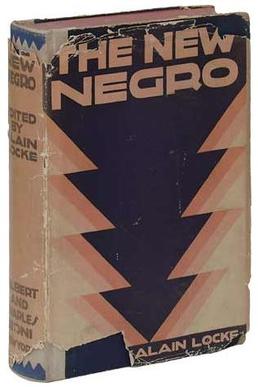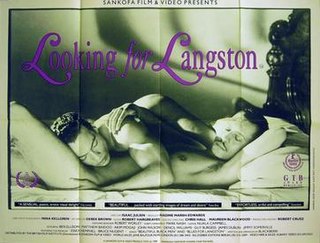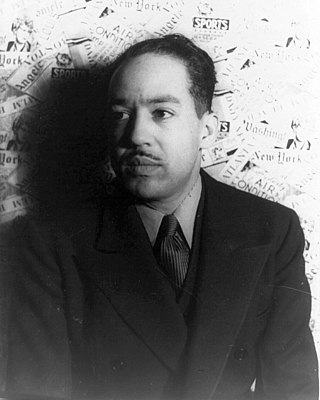
Nicolás Cristóbal Guillén Batista was a Cuban poet, journalist, political activist, and writer. He is best remembered as the national poet of Cuba.

Countee Cullen was an American poet, novelist, children's writer, and playwright, particularly well known during the Harlem Renaissance.

Margaret Walker was an American poet and writer. She was part of the African-American literary movement in Chicago, known as the Chicago Black Renaissance. Her notable works include For My People (1942) which won the Yale Series of Younger Poets Competition, and the novel Jubilee (1966), set in the South during the American Civil War.

Arna Wendell Bontemps was an American poet, novelist and librarian, and a noted member of the Harlem Renaissance.

The New Negro: An Interpretation (1925) is an anthology of fiction, poetry, and essays on African and African-American art and literature edited by Alain Locke, who lived in Washington, DC, and taught at Howard University during the Harlem Renaissance. As a collection of the creative efforts coming out of the burgeoning New Negro Movement or Harlem Renaissance, the book is considered by literary scholars and critics to be the definitive text of the movement. "The Negro Renaissance" included Locke's title essay "The New Negro", as well as nonfiction essays, poetry, and fiction by writers including Countee Cullen, Langston Hughes, Zora Neale Hurston, Claude McKay, Jean Toomer, and Eric Walrond.

Kevin Young is an American poet and the director of the Smithsonian Institution National Museum of African American History and Culture since 2021. Author of 11 books and editor of eight others, Young previously served as Director of the Schomburg Center for Research in Black Culture at the New York Public Library. A winner of a Guggenheim Fellowship as well as a finalist for the National Book Award for his 2003 collection Jelly Roll: A Blues, Young was Atticus Haygood Professor of English and Creative Writing at Emory University and curator of Emory's Raymond Danowski Poetry Library. In March 2017, Young was named poetry editor of The New Yorker.
Gilbert Price was an American operatic baritone and actor.
Naomi Long Madgett was an American poet and publisher. Originally a teacher, she later found fame with her award-winning poems and was also the founder and senior editor of Lotus Press, established in 1972, a publisher of poetry books by black poets. Known as "the godmother of African-American poetry", she was the Detroit poet laureate since 2001.

Sonia Sanchez is an American poet, writer, and professor. She was a leading figure in the Black Arts Movement and has written over a dozen books of poetry, as well as short stories, critical essays, plays, and children's books. In the 1960s, Sanchez released poems in periodicals targeted towards African-American audiences, and published her debut collection, Homecoming, in 1969. In 1993, she received Pew Fellowship in the Arts, and in 2001 was awarded the Robert Frost Medal for her contributions to the canon of American poetry. She has been influential to other African-American poets, including Krista Franklin.
Arnold Rampersad is a biographer, literary critic, and academic, who was born in Trinidad and Tobago and moved to the US in 1965. The first volume (1986) of his Life of Langston Hughes was a finalist for the Pulitzer Prize and his Ralph Ellison: A Biography was a finalist for the 2007 National Book Award.

Looking for Langston is a 1989 British black-and-white film, directed by Isaac Julien and produced by Sankofa Film & Video Productions. It combines authentic archival newsreel footage of Harlem in the 1920s with scripted scenes to produce a non-linear impressionistic storyline celebrating black gay identity and desire during the artistic and cultural period known as the Harlem Renaissance in New York. The film has a runtime of about 42 minutes.
Hans Ansgar Ostrom is an American professor, writer, editor, and scholar. Ostrom is a professor of African American Studies and English the University of Puget Sound (1983–present), where he teaches courses on African-American literature, creative writing, and poetry as a genre. He is known for his authorship of various books on African-American studies and creative writing, and novels including Three to Get Ready, Honoring Juanita, and Without One, as well as The Coast Starlight: Collected Poems 1976–2006.

James Mercer Langston Hughes was an American poet, social activist, novelist, playwright, and columnist from Joplin, Missouri. One of the earliest innovators of the literary art form called jazz poetry, Hughes is best known as a leader of the Harlem Renaissance. He famously wrote about the period that "the Negro was in vogue", which was later paraphrased as "when Harlem was in vogue."
Montage of a Dream Deferred is a book-length poem suite published by Langston Hughes in 1951. Its jazz poetry style focuses on scenes over the course of a 24-hour period in Harlem and its mostly African-American inhabitants. The original edition was 75 pages long and comprised 91 individually titled poems, which were intended to be read as a single long poem. Hughes' prefatory note for the book explained his intentions in writing the collection:
In terms of current Afro-American popular music and the sources from which it progressed—jazz, ragtime, swing, blues, boogie-woogie, and be-bop—this poem on contemporary Harlem, like be-bop, is marked by conflicting changes, sudden nuances, sharp and impudent interjections, broken rhythms, and passages sometimes in the manner of a jam session, sometimes the popular song, punctuated by the riffs, runs, breaks, and disc-tortions of the music of a community in transition.

"The Negro Speaks of Rivers" is a poem by American writer Langston Hughes. Hughes wrote the poem when he was 17 and crossing the Mississippi River on the way to visit his father in Mexico. It was first published the following year in The Crisis, starting Hughes's literary career. "The Negro Speaks of Rivers" uses rivers as a metaphor for Hughes's life and the broader African-American experience. It has been reprinted often and is considered one of Hughes's most famous and signature works.
"Advertisement for the Waldorf-Astoria" is a two-page poem by Langston Hughes, accompanied by illustrations by Walter Steinhilber, which takes the form of a parody of a magazine advertisement. The poem was first published in The New Masses in December 1931 and later in Hughes's autobiography of that time period, The Big Sea. The poem is considered one of Hughes' most direct indictments of economic inequality of the 1930s.
Poetry for Young People: Langston Hughes is a 2006 children's poetry collection by Langston Hughes edited by David Roessel and Arnold Rampersad and illustrated by Benny Andrews, originally published by Sterling Publishing Company.
"Harlem" is a poem by Langston Hughes. These eleven lines ask, "What happens to a dream deferred?", providing reference to the African-American experience. It was published as part of a longer volume-length poem suite in 1951 called Montage of a Dream Deferred, but is often excerpted from the larger work. The play A Raisin in the Sun was titled after a line in the poem.

The Sweet Flypaper of Life is a 1955 fiction and photography book by American photographer Roy DeCarava and American writer Langston Hughes. DeCarava's photos and Hughes's story, told through the character Sister Mary Bradley, depict and describe Black family life in Harlem, New York City, in the 1950s.
Mary Sampson Patterson Leary Langston (1835-1915) was an American abolitionist, the first Black woman to attend Oberlin College, and wife of notable abolitionists Lewis Sheridan Leary and Charles Henry Langston. She was also the grandmother of Langston Hughes and raised him for part of his childhood, inspiring his future work.











